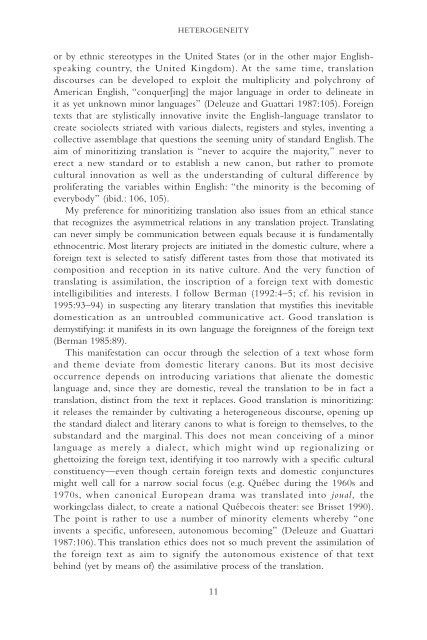THE SCANDALS OF TRANSLATION
9781134740642_sample_893345
9781134740642_sample_893345
Create successful ePaper yourself
Turn your PDF publications into a flip-book with our unique Google optimized e-Paper software.
HETEROGENEITYor by ethnic stereotypes in the United States (or in the other major Englishspeakingcountry, the United Kingdom). At the same time, translationdiscourses can be developed to exploit the multiplicity and polychrony ofAmerican English, “conquer[ing] the major language in order to delineate init as yet unknown minor languages” (Deleuze and Guattari 1987:105). Foreigntexts that are stylistically innovative invite the English-language translator tocreate sociolects striated with various dialects, registers and styles, inventing acollective assemblage that questions the seeming unity of standard English. Theaim of minoritizing translation is “never to acquire the majority,” never toerect a new standard or to establish a new canon, but rather to promotecultural innovation as well as the understanding of cultural difference byproliferating the variables within English: “the minority is the becoming ofeverybody” (ibid.: 106, 105).My preference for minoritizing translation also issues from an ethical stancethat recognizes the asymmetrical relations in any translation project. Translatingcan never simply be communication between equals because it is fundamentallyethnocentric. Most literary projects are initiated in the domestic culture, where aforeign text is selected to satisfy different tastes from those that motivated itscomposition and reception in its native culture. And the very function oftranslating is assimilation, the inscription of a foreign text with domesticintelligibilities and interests. I follow Berman (1992:4–5; cf. his revision in1995:93–94) in suspecting any literary translation that mystifies this inevitabledomestication as an untroubled communicative act. Good translation isdemystifying: it manifests in its own language the foreignness of the foreign text(Berman 1985:89).This manifestation can occur through the selection of a text whose formand theme deviate from domestic literary canons. But its most decisiveoccurrence depends on introducing variations that alienate the domesticlanguage and, since they are domestic, reveal the translation to be in fact atranslation, distinct from the text it replaces. Good translation is minoritizing:it releases the remainder by cultivating a heterogeneous discourse, opening upthe standard dialect and literary canons to what is foreign to themselves, to thesubstandard and the marginal. This does not mean conceiving of a minorlanguage as merely a dialect, which might wind up regionalizing orghettoizing the foreign text, identifying it too narrowly with a specific culturalconstituency—even though certain foreign texts and domestic conjuncturesmight well call for a narrow social focus (e.g. Québec during the 1960s and1970s, when canonical European drama was translated into joual, theworkingclass dialect, to create a national Québecois theater: see Brisset 1990).The point is rather to use a number of minority elements whereby “oneinvents a specific, unforeseen, autonomous becoming” (Deleuze and Guattari1987:106). This translation ethics does not so much prevent the assimilation ofthe foreign text as aim to signify the autonomous existence of that textbehind (yet by means of) the assimilative process of the translation.11


